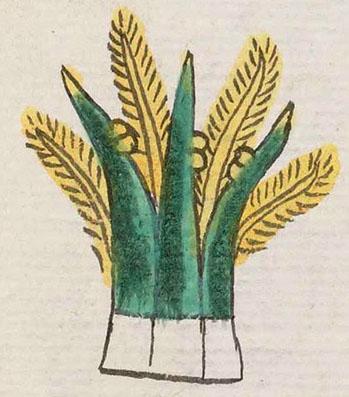Zacatollan (Mdz38r)
This compound glyph for the place name Zacatollan includes two obvious elements, yellow grasses and green tules or reeds. Four sprigs of yellow grasses (zacatl) appear behind three green reeds (tolin) that have white bases and small, rounded protrusions toward the top of the stalks. The green of the reeds has two tones, with the darker green on what may be the outside and a lighter green on the inside
Stephanie Wood
We are accepting that the locative suffix is -tlan (place of) rather than -tla (or tlah-) (place of abundance of), but as always, this can be deceptive if there is an intrusive "n" or one that has inadvertently dropped away. The base of the tules consists of something resembling white teeth, which may be a coincidence. But the teeth (tlantli), if they were indeed meant to be read, could provide the phonetic dimension -tlan.
Stephanie Wood
çacatulan.puo
Zacatollan, pueblo
Stephanie Wood
c. 1541, or by 1553 at the latest
Stephanie Wood
Or possibly three, if the -tlan locative suffix is visible at the base of the tules.
grasses, tules, zacate, pasto, Zacatulan, Zacatullan, Çacatulan, Çacatolan, Çcacatollan, nombres de lugares

zaca(tl), grasses, https://nahuatl.wired-humanities.org/content/zacatl
toll(in), rushes or tule reeds, https://nahuatl.wired-humanities.org/content/tollin
-tlan (locative suffix), place of, https://nahuatl.wired-humanities.org/content/tlan
"Grass-Reed Place" [Frances Karttunen, unpublished manuscript, used here with her permission.]
"Place Where Grass and Reeds Abound" (Berdan and Anawalt, 1992, vol. 1, p. )
"El Lugar del Zacate-Juncia" o "Lugar del Zacate-Espadaña"
Stephanie Wood
Codex Mendoza, folio 38 recto, https://digital.bodleian.ox.ac.uk/objects/2fea788e-2aa2-4f08-b6d9-648c00..., image 86 of 188.
The Bodleian Libraries, University of Oxford, hold the original manuscript, the MS. Arch. Selden. A. 1. This image is published here under the UK Creative Commons, “Attribution-NonCommercial-ShareAlike 3.0 License” (CC-BY-NC-SA 3.0).



